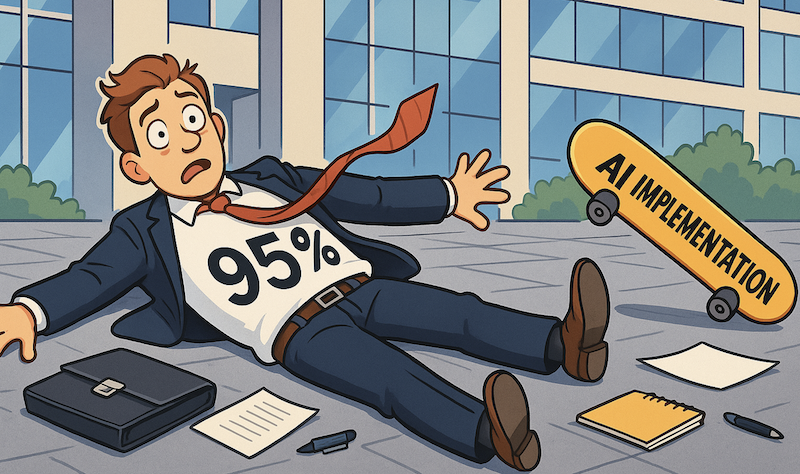Why 95% of Businesses Fail at AI (And How You Can Be in the 5%)
/The headlines are shifting, and honestly? It's giving me whiplash.
Just months ago, AI dominated every news cycle. Promises of transformation here, warnings about falling behind there. Now we're hearing a completely different story: "95% of businesses see no ROI from AI," "We're in an AI bubble," and concerns about reliability and sustainability.
If you're an entrepreneur or running a growth-stage company, this creates one massive question: Should you invest in AI or wait it out?
Here's the thing - the answer isn't as simple as the headlines suggest.
The Real Story Behind That 95% Statistic
Let me tell you what everyone's missing about that MIT study.
Yes, 95% of organizations aren't seeing enterprise-level ROI from their AI initiatives. But here's the plot twist nobody's talking about: individuals within those same organizations are reporting increased productivity and efficiency using AI tools.
So what's the disconnect?
It's not that AI doesn't work. It's that most companies are implementing it completely wrong. They're treating AI like some magic solution instead of what it actually is - a strategic tool that requires thoughtful integration.
Meanwhile, you've got Microsoft and Amazon investing billions in AI infrastructure and seeing significant returns. The technology itself isn't broken. It's how smaller organizations are approaching implementation that's the problem.
Let's Get Real About Human + AI
Before we dive into solutions, can we address the elephant in the room?
AI isn't going to replace your entire workforce next year. Despite all the autonomous AI hype, today's reality is different. AI excels as your copilot - handling the repetitive stuff, augmenting what your team already does well, and freeing everyone up for the high-value work that requires human judgment, creativity, and relationship-building.
The companies winning with AI? They've figured out this partnership model. AI does the grunt work while humans provide oversight, strategy, and that personal touch that builds lasting business relationships.
It's collaboration, not replacement.
Three Steps to Join the 5% That Actually See Results
After working with organizations on AI implementation, I've noticed three critical factors that separate the winners from the wannabes:
1. Stop Implementing AI Because It's Trendy
Here's the biggest mistake I see: companies implementing AI because it's cool, not because it solves a real problem.
I call this the "sprinkles on ice cream" approach. You're just adding AI features without any clear purpose, and guess what? That guarantees failure every single time.
Instead, focus on problems that directly hit your bottom line. Ask yourself:
What repetitive tasks are eating up your team's valuable time?
Where are broken processes delaying deals or increasing costs?
What's preventing your team from moving faster toward revenue?
I know, I know, you want real examples. Since this is a Pitch Lab blog, here’s a few from the world of sales:
Information hunting: How much time do your salespeople waste digging for past contracts, marketing collateral, or proposal templates? AI can create a centralized, searchable knowledge base that delivers instant answers.
New hire onboarding: Is your sales manager stretched thin answering the same questions from new reps over and over? An AI-powered Q&A system can handle first-level support, freeing up managers for actual strategic coaching and getting your new hires to revenue contributors quicker.
Call coaching at scale: AI can audit sales calls against your playbook, providing immediate feedback to reps and highlighting exactly where managers need to focus training efforts.
The key? Measurable impact. If you can't quantify how the solution will save time, reduce costs, or accelerate revenue, keep looking.
2. You Don't Need to Break the Bank
There's this dangerous misconception floating around that effective AI always requires hundreds of thousands of dollars in custom development.
That's not necessarily true.
The barrier to entry is lower than it's ever been. Powerful, low-code and no-code platforms cost as little as $20 per month and can handle sophisticated business processes.
Consider tools like:
Make.com for workflow automation
Zapier for connecting different systems
n8n for technical workflow automation
Vector Shift for no-code AI workflow building
Custom GPTs for specialized knowledge assistants
Before choosing any technology though, think about maintenance. Will you handle updates internally, or do you need external support? Factor these ongoing costs into your decision from day one.
3. The People Challenge (This Is Where CEOs Struggle the Most)
Here's what nobody wants to talk about: the technology is often the easy part.
The hard part? Getting your team on board.
Even when employees say they love AI, those constant headlines about job displacement create real anxiety. This fear shows up as subtle but powerful resistance:
Finding edge cases where "AI won't work"
Throwing up roadblocks to slow implementation
Creating elaborate reasons why existing processes can't change
I know one CEO who described his frustration perfectly. Despite having a brilliant and clear vision for AI integration, every single proposal to his team was met with resistance, edge cases, and - no joke - literal yawn emojis 🥱 in response to new AI solutions.
So how do CEOs overcome this resistance?
Address fears head-on: Be transparent about how AI will change roles, not eliminate them.
Show, don't tell: Start with small wins that demonstrate value without threatening anyone's position.
Find your champions: Identify team members who are naturally excited about AI and leverage their enthusiasm.
Focus on empowerment: Frame AI as a tool that makes people more effective, not more expendable.
Remember this: if your current process doesn't work manually, AI won't magically fix it. Optimize your workflows first, then add AI to amplify what's already working.
The Bottom Line
The AI revolution is real. But it's not about replacing humans today - it's about amplifying human capabilities.
The companies that recognize this and implement AI strategically won't just survive the current uncertainty. They'll use it as a massive competitive advantage while their competitors are still sitting around debating whether the technology is worth the investment.
The question isn't whether AI will reshape business. That's already happening.
The question is whether your company will be among the 5% that figures out how to harness it effectively.
About the Author
Toni Mays has 20+ years in technology, with the last 6 years focused specifically on helping organizations use AI effectively. As the founder of Mozman AI Consulting, she's helped everyone from small nonprofits to large companies find practical ways to save time and money with automation. For organizations ready to join the 5% that see real AI ROI, learn more about Toni here.



